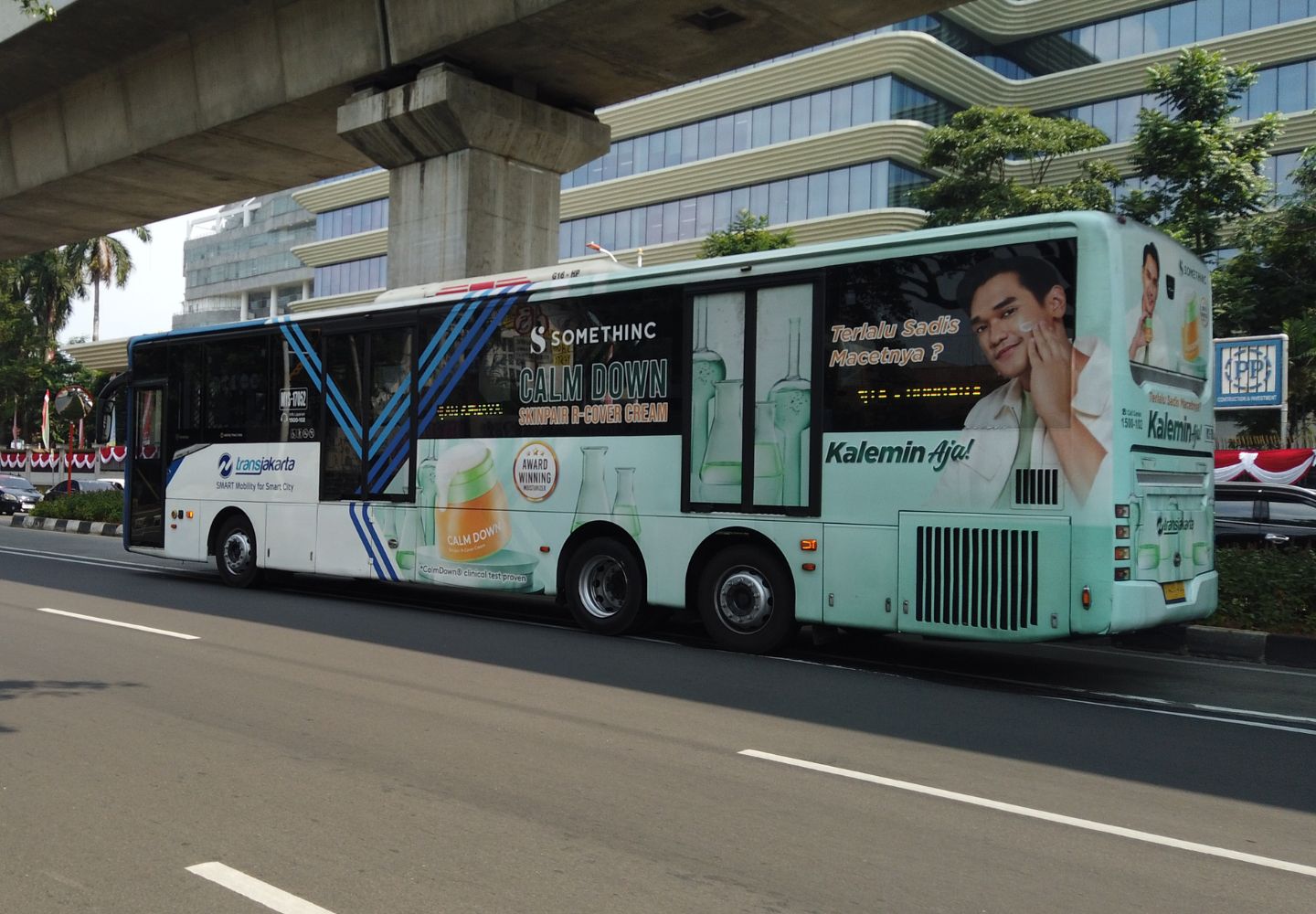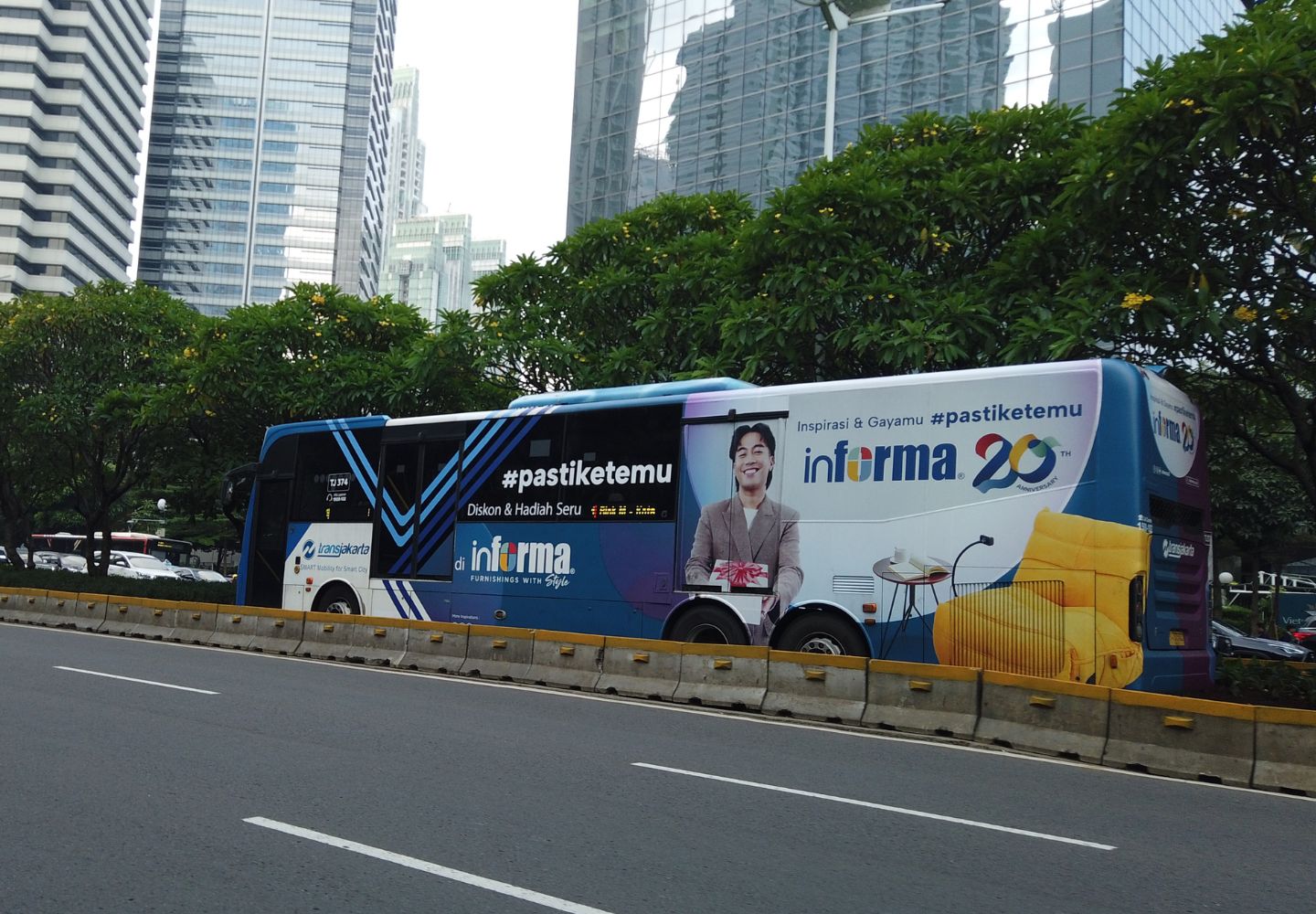In the world of Out-of-Home (OOH) advertising, public transportation has become one of the most captivating media channels for many brands. With high mobility and daily exposure to thousands of commuters, TransJakarta buses offer a strategic advertising opportunity. Yet, many marketers still find themselves torn between two options: which is more effective, BRT or Non-BRT?
This confusion is understandable. Without a clear understanding of their differences, brands risk misallocating advertising budgets and missing their target audience. Each transportation mode has its own unique characteristics that significantly influence campaign effectiveness.
So, which one suits your brand best, the centralized BRT system or the more widespread Non-BRT network? To answer that, let’s dive deeper into the distinctions between the two, both from a transportation and advertising perspective.
Picture an office worker commuting every morning along Jakarta’s main corridor using the BRT. Seated comfortably, laptop open, they enjoy a smooth ride on a dedicated lane. Meanwhile, a university student in South Jakarta hops on a Non-BRT bus from near their boarding house, alighting flexibly closer to campus, no transfers, no hassle.
Both are TransJakarta passengers, yet their experiences differ vastly. These are the two faces of Jakarta’s transit system: BRT (Bus Rapid Transit), known for its efficiency and speed along major routes, and Non-BRT, which covers broader areas and integrates more naturally with people’s daily routines.
This difference makes both modes not only essential for urban mobility but also powerful advertising platforms, each offering access to distinct audience segments.

Source: City Vision
To truly understand the difference between BRT and Non-BRT, we first need to look at them from a transportation system perspective:
Dedicated Lane: BRT operates on exclusive lanes, free from general traffic congestion.
Speed and Punctuality: Thanks to its dedicated corridor, travel times are more consistent and reliable.
Audience Focus: The majority of passengers are office workers, students, and medium- to long-distance commuters.
Brand Impression: Modern, orderly, and efficient—ideal for brands seeking a professional and premium image.
Flexible Routes: Non-BRT buses reach residential areas and inner-city roads not covered by the BRT corridor.
High Mobility: More dynamic, with frequent stops and a broader reach..
Diverse Audience: Students, homemakers, field workers, and local tourists.
Brand Impression: Approachable and relatable, ideal for brands that want to appear human-centered, friendly, and accessible.
In simple terms, BRT is centralized and exclusive, while Non-BRT is widespread and people-oriented. These two characteristics create distinct advertising potentials.
Advertising within the BRT system carries an air of exclusivity. The interiors of BRT shelters and buses are designed to be modern, clean, and organized, an ideal environment for brands targeting upper-middle-class consumers or young professionals.
Advantages of BRT Advertising:
Captive Audience: Passengers spend significant time inside buses or stations, providing longer ad exposure and stronger recall.
Premium Ad Spaces: Media placements on glass walls, in-shelter panels, and digital screens inside buses offer strategic visibility.
Central Corridors: Since BRT routes pass through Jakarta’s main arteries, such as Sudirman–Thamrin and Harmoni, Blok M, your brand gains exposure in the heart of the city’s business and commercial activities.
In short, BRT is ideal for brands that want to project an image of elegance, professionalism, and credibility, such as those in finance, technology, or urban lifestyle sectors.

Source: City Vision
Meanwhile, Non-BRT serves as an attractive choice for brands seeking to expand their reach. With routes that extend into densely populated neighborhoods and suburban areas, Non-BRT connects with a broader and more diverse audience.
Key advantages of advertising on Non-BRT:
Moving Billboard: The bus exterior acts as a mobile advertising medium, viewed by thousands of people daily on the roads.
Interior Branding: Passengers inside the bus are exposed to the ad for a longer duration throughout their journey.
Maximum Reach: Penetrates smaller streets and residential areas, creating awareness across all community segments.
Non-BRT advertising is highly effective for consumer goods, food and beverage, retail, and digital service brands that aim for wide-scale and continuous awareness distribution.
When viewed through the lens of target audience and campaign objectives, effectiveness depends on your brand strategy:
|
Aspect |
BRT |
Non BRT |
|
Audience |
Professionals, office workers, students |
General public, students, homemakers |
|
Coverage Area |
Main city corridors |
Broader areas including residential zones |
|
Brand Image |
Premium, modern, professional |
Approachable, mass-market, dynamic |
|
Ad Format |
Bus shelters, bus interiors, digital screens |
Bus body, interior, rear branding |
|
Ideal Objective |
Targeted positioning and awareness |
Massive awareness and broad engagement |
In conclusion:
BRT = Focused reach and premium positioning.
Non-BRT = Wide coverage and flexible routing.
For national brands, combining both can create a powerful OOH dominance strategy, where one builds a premium image while the other strengthens brand reach within the community.
Also read: How to Ride TransJakarta Non-BRT & Easily Launch Ads
As one of Jakarta’s leading Out-of-Home media players, City Vision fully understands the characteristics and strengths of each transportation mode.
Why City Vision stands out:
Media Mastery: Exclusive access to strategic BRT and Non-BRT locations.
Comprehensive Strategy: More than just selling ad space, City Vision helps brands choose the transportation mode that best fits their target audience.
Unskippable Ads: Ads on public transport cannot be skipped, ensuring your brand message truly reaches its audience.
A Stage for Brand Flexing: Appearing in public spaces showcases your brand’s strength and credibility to a wide audience.
With this approach, City Vision transforms BRT and Non-BRT from mere transportation systems into vast canvases where your brand can stand out and be remembered.
City Vision is Jakarta’s leading OOH partner, dbacked by extensive experience in delivering impactful and efficient campaigns.
Reasons to choose City Vision:
Flexible Packages: Choose to focus on BRT, Non-BRT, or a combination of both.
Data-Driven Strategy: Every decision is supported by audience and location research.
Professional Execution: From design to monitoring, every stage is handled with an integrated approach.
Proven Results: Numerous national brands trust City Vision to connect their campaigns with millions of Jakarta commuters every day.
City Vision ensures that public transportation is not just a vehicle, but a grand stage for your brand to shine.
Also read: TransJakarta Non-BRT Bus Routes & How to Maximize OOH Advertising Potential
Now you’ve learned the key differences between BRT and Non-BRT, along with their unique advantages.
BRT delivers targeted and premium exposure.
Non-BRT offers massive reach and strong community connection.
With City Vision, you don’t have to choose one over the other. You can leverage both within an integrated strategy that ensures your brand is not only seen but remembered.
Whatever your choice, BRT or Non-BRT, make sure your campaign is executed with City Vision, Jakarta’s best OOH partner.